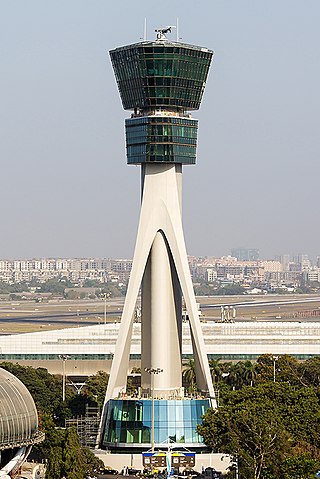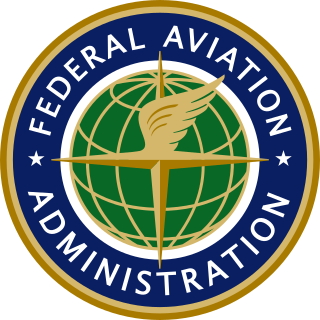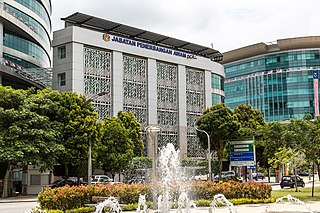
Air traffic control (ATC) is a service provided by ground-based air traffic controller who direct aircraft on the ground and through a given section of controlled airspace, and can provide advisory services to aircraft in non-controlled airspace. The primary purpose of ATC worldwide is to prevent collisions, organize and expedite the flow of air traffic, and provide information and other support for pilots.
NATS Holdings, formerly National Air Traffic Services and commonly referred to as NATS, is provides en-route air traffic control services to flights within the UK flight information regions and the Shanwick Oceanic Control Area. It also provides air traffic control services to 14 UK airports.

The Irish Aviation Authority (IAA) is a commercial semi-state company in Ireland responsible for the regulation of safety aspects of air travel. It is also responsible for providing air traffic control services to Ireland's three main airports, namely Dublin, Shannon and Cork. Its head office is in The Times Building in Dublin.

ENAIRE is the air navigation manager in Spain, certified for the provision of en route, approach and aerodrome control services. As a public corporate entity attached to the Spanish Ministry of Public Works, it is responsible for air traffic control, aeronautical information and the Communication, navigation and surveillance networks - these are all necessary so that air companies and their aircraft can fly safely, fluidly and in an organised format within Spanish airspace.

The European Organisation for the Safety of Air Navigation, commonly known as Eurocontrol, is an international organisation working to achieve safe and seamless air traffic management across Europe. Founded in 1960, Eurocontrol currently has 41 member states and is headquartered in Brussels, Belgium. It has several local sites as well, including an Innovation Hub in Brétigny-sur-Orge, France, the Aviation Learning Centre (ALC) in Luxembourg, and the Maastricht Upper Area Control Centre (MUAC) in Maastricht, the Netherlands. The organisation employs approximately two thousand people, and operates with an annual budget in excess of half a billion Euro.

Airservices Australia is an Australian Government owned corporation, responsible for providing safe, secure, efficient and environmentally responsible services to the aviation industry within the Australian Flight Information Region (FIR). Some of Airservices responsibilities include air traffic control, airways navigation and communication facilities, publishing aeronautical data and airport rescue and fire-fighting services. Airservices Australia has international partnerships with ICAO, CANSO and IATA.

The Airports Authority of India, or AAI, is a public sector enterprise under the ownership of the Ministry of Civil Aviation, Government of India. It is responsible for creating, upgrading, maintaining, and managing civil aviation infrastructure in India. It provides Communication Navigation Surveillance/Air Traffic Management (CNS/ATM) services over the Indian airspace and adjoining oceanic areas. AAI currently manages a total of 137 airports, including 34 international airports, 10 Customs Airports, 81 domestic airports, and 23 Civil enclaves at Defense airfields. AAI also has ground installations at all airports and 25 other locations to ensure the safety of aircraft operations. AAI covers all major air routes over the Indian landmass via 29 Radar installations at 11 locations along with 700 VOR/DVOR installations co-located with Distance Measuring Equipment (DME). 52 runways are provided with Instrument landing system (ILS) installations with Night Landing Facilities at most of these airports and an Automatic Message Switching System at 15 Airports.
Skyguide is an air navigation service provider which manages and monitors Swiss airspace. The company, which was formerly known as Swisscontrol, changed its name to skyguide in 2001. Skyguide is a joint-stock company under Swiss private law which is responsible, on behalf of the Swiss Confederation, for ensuring the safety of all Swiss airspace and of adjoining airspace areas in Germany, Austria, France and Italy that have been delegated to its control. For Swiss airspace, this duty extends to both civil and military air navigation services.
The Future Air Navigation System (FANS) is an avionics system which provides direct data link communication between the pilot and the air traffic controller. The communications include air traffic control clearances, pilot requests and position reporting. In the FANS-B equipped Airbus A320 family aircraft, an Air Traffic Services Unit (ATSU) and a VHF Data Link radio (VDR3) in the avionics rack and two data link control and display units (DCDUs) in the cockpit enable the flight crew to read and answer the controller–pilot data link communications (CPDLC) messages received from the ground.
The Next Generation Air Transportation System (NextGen) is an ongoing United States Federal Aviation Administration (FAA) project to modernize the National Airspace System (NAS). The FAA began work on NextGen improvements in 2007 and plans to finish the final implementation segment by 2030. The goals of the modernization include using new technologies and procedures to increase the safety, efficiency, capacity, access, flexibility, predictability, and resilience of the NAS while reducing the environmental impact of aviation.

The Air Traffic Organization (ATO) is an air navigation service provider in the United States of America. The ATO is the operational division of the Federal Aviation Administration (FAA).
The General Civil Aviation Authority (GCAA) in the United Arab Emirates (UAE) was established in 1996 by Federal Cabinet Decree to regulate Civil Aviation and provide designated aviation services with emphasis on safety and security and to strengthen the aviation industry within the UAE and its upper airspace. The main office is located in Abu Dhabi and the regional office is located in Dubai to serve the northern Emirates. The GCAA, which is the sole authority for the control and regulation of civil aviation in the UAE, is responsible for the provision of en-route air navigation services and all aspects of flight safety. In late 2009, the GCAA opened its new Air Navigation Centre, The Sheikh Zayed Centre, which is considered the largest and busiest air traffic management facility in the Middle East as well as one of the world's most technically advanced centres in terms of its design.

The Civil Aviation Authority of Malaysia, previously known as the Department of Civil Aviation, is a government agency that was formed under the Ministry of Transport Malaysia in 1969. Effectively on 19 February 2018, DCA was incorporated into a statutory body known as CAAM.
The State Secretariat of Civil Aviation is an agency of the government of Cambodia in-charge of civil aviation including airports in the country. It is headquartered in the capital Phnom Penh. The SSCA oversees the operation of national airports and air traffic management system in Cambodia. In 2000, it granted lease to SAMART Corporation to operate and upgrade the country's air traffic control and air navigation system under a long-term concession. The Secretary of State in charge is Mao Havannall.
BULATSA is the Bulgarian Air Traffic Services Authority, a branch of the Bulgarian Civil Aviation Administration responsible for air traffic management within Bulgaria's airspace.
skeyes, officially called Belgocontrol or in its complete form the Authority of airways, is the Belgian air navigation and traffic service provider for the civil airspace for which the Belgian State is responsible. It was created in 1998.
Karachi Area Control Centre is one of two Area Control Centers in Pakistan operated by the Pakistan Civil Aviation Authority and is based in Terminal 1 at Jinnah International Airport in Karachi. Karachi ACC air traffic controllers provide en route and terminal control services to aircraft in the Karachi Flight Information Region. The Karachi FIR airspace covers Pakistani airspace between the 30° North to 23° North. To the north is the Lahore FIR. To the east is the Delhi FIR. To the south is the Muscat FIR and to the west are the Tehran FIR and Kabul FIRs.
Lahore Area Control Centre is one of two Area Control Centers in Pakistan operated by the Pakistan Civil Aviation Authority and based at Allama Iqbal International Airport in Lahore. Lahore ACC air traffic controllers provide en route and terminal control services to aircraft in the Lahore Flight Information Region (FIR). The Lahore FIR airspace covers Pakistani airspace between the 30° North to 37° North. To the south is the Karachi FIR. To the north is the Urumqi FIR. To the east is the Delhi FIR. To the west is the Kabul FIR.
Communication, navigation and surveillance (CNS) are the main functions that form the infrastructure for air traffic management, and ensure that air traffic is safe and efficient.
Unmanned aircraft system traffic management (UTM) is an air traffic management ecosystem under development for autonomously controlled operations of unmanned aerial systems (UAS) by the FAA, NASA, other federal partner agencies, and industry. They are collaboratively exploring concepts of operation, data exchange requirements, and a supporting framework to enable multiple UAS operations beyond visual line-of-sight at altitudes under 400 ft above ground level in airspace where FAA air traffic services are not provided.







